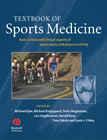The Textbook of Sports Medicine provides comprehensive coverage of
both basic science and clinical aspects of sports injury and physical
activity. More than one hundred of the World's leading authorities
within exercise physiology, clinical internal medicine, sports
medicine and traumatology have contributed with evidence-based state-
of-the-art chapters to produce the most complete integration ever of
sports medicine science into one book.
Great attention has been given to providing balanced coverage of all
aspects of sports medicine, with respect to the relevance and
clinical importance of each area. The book isolates solid principles
and knowledge, and the documentation to support these, as well as
identifying areas where further scientific investigation is needed.
The topics dealt with and the degree of detail in the individual
chapters, makes the book ideal for both educational programs at
University level within exercise science and sports medicine, as well
as for post-graduate courses within all aspects of sports medicine.
In addition, the book will be excellent as a reference book in any
place where professionals whether doctors, exercise scientists,
physiotherapists or coaches are dealing with supervision or treatment
of sports-active individuals. Finally, the book is well structured to
act as an introduction to research in the field of sports medicine.
-Contents -
Section 1: Basic science of physical activity and sports injuries -
Principles of training.
1.1 Cardiovascular and respiratory adaptation to physical training
1.2 Metabolism during exercise - energy expenditure, hormonal changes
1.3 Skeletal muscle: physiology, training and repair after injury
1.4 Neuromuscular aspects and joint neurophysiology in exercise -
adaptive responses evoked by strength training
1.5 Biomechanics of locomotion
1.6 Connective tissue in ligaments, tendon and muscle: physiology and
repair, and musculoskeletal flexibility 1.7 Cartilage tissue -
loading and overloading
1.8 Bone tissue -training and injury.
Section 2: Aspects of human performance
2.1 Recovery after training - inflammation, metabolism, and tissue
repair, overtraining
2.2 Principles of Rehabilitation following sports injuries
2.3 Physical activity and environment
2.4 Nutrition and fluid intake with training
2.5 Ergogenic aids (doping) and pharmacological injury treatment.
Section 3: Physical achievements vs sports injury
3.1 Epidemiology and prevention of sports injuries
3.2 Exercise as disease prevention
3.3 Physical activity in the elderly
3.4 Exercise in healthy children and in those who have a chronic
disease
3.5 Disabled individuals and exercise
Section 4: Exercise in acute and chronic medical diseases
4.1 Athletes' heart - cardiovascular and peripheral vessel diseases
4.2 Exercise and infectious diseases
4.3 Osteoarthritis
4.4 Exercise in the treatment of type 2 and 1 diabetes
4.5 Asthma and chronic airway disease
4.6 Amenorrhea, osteoporosis, and eating disorders in athletes
4.7 Physical Activity and obesity
4.8 Exercise in acute snd chronic medical conditions:
gastrointestinal considerations
Section 5: Imaging in Sports Injuries
5.1 Imaging in Sports Injuries
Section 6: Regional considerations
6.1 Lower leg, ankle and foot
6.2 Knee
6.3 Athletic injuries to the hip, groin and pelvis
6.4 Head injuries
6.5 Spine
6.6 Shoulder
6.7 Elbow, wrist and hand
6.8 Practical sports and medicine


